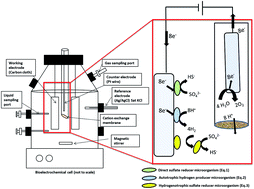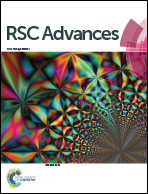Methanobacterium enables high rate electricity-driven autotrophic sulfate reduction
Abstract
The autotrophic reduction of sulfate can be sustained with a cathode as the only electron donor in bioelectrochemical systems (BES). This work studies the effect of inoculum source on autotrophic sulfate reduction start-up and performance of autotrophic sulfide production rates using a biocathode in a fed-batch operation mode. After 180 days, low electron and sulfate consumption was observed using BES controlled at −0.9 V vs. SHE and inoculated with mixed microbial consortia from sewer biofilm reactors, anaerobic sludge and mangrove sediments. However, when an enriched electroactive consortium capable of cathodic CO2 reduction to acetate was used as biocatalyst in combination with the above inocula, the maximal cathodic current increased to −3.4 A m−2 within 55 days at the same applied potential. High-throughput microbial community sequencing revealed that enhanced performance was likely caused by the enrichment of hydrogen-producing Methanobacterium (26% relative abundance). The biofilm and planktonic cells also contained the autotrophic hydrogen and sulfate consumer Desulfovibrio at 2.8% relative abundance. The resulting microbial community demonstrated sulfate and electron consumption rates of 0.115 ± 0.009 mol SO42−–S per m2 per d and 1.5 ± 0.7 mol m−2 d−1 (39 times higher sulfate reduction rate and 186-fold cathodic electron consumption rate than control reactors with the same configuration but lacking the enriched electroactive consortia). Cyclic voltammetry furthermore revealed a positive shift of the cathodic onset current by ∼0.2 V, which points to the electrocatalytic role of the biocatalyst.


 Please wait while we load your content...
Please wait while we load your content...